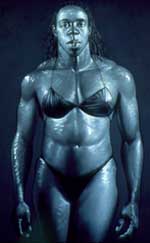
Such large anger recently over such small art. I can understand the resentments of working artists who feel neglected by a show like the Whitney Biennial, but anger best accompanies the struggle over great art. It should not be wasted on mediocre work that, after all, has committed no crime. Social comedy is the right note for this period of mannerist exhaustion when artists, curators, and critics try to revive spent conventions in art with hothouse effects. Tin-pot mayors and elephant dung. Pictures made with melted chocolate. They all deserve a wry smile. So does Picturing the Modern Amazon, a show about female bodybuilders that opened recently at the New Museum of Contemporary Art. There could be no better – or, in its way, more comic – illustration of the weakness of contemporary art masquerading as strength.
The exhibit pays homage to many of the fashionable obsessions in modern and contemporary culture: the role of gender and female stereotypes, the place of the marginal or transgressive, the existential style of subcultures and the circus, the flourishing of pop past and present (postcards, comic books, advertisements). As I stared at an enormous picture of the oiled thighs of a female bodybuilder, a person near me began discussing “the body as a cultural construct.” It’s always surprising when people talk, not just write, in contemporary Latin. What’s comical, however, is to see this intellectual edifice – which is constructed with earnest, respectful, and unrelenting piety – rise upon buns of steel.
“Picturing the Modern Amazon” includes some work by contemporary artists – among them Cindy Sherman, Matthew Barney, and Andres Serrano – but the sociology is more interesting than the art. For most of the past three centuries, the idea of women performing feats of strength was regarded as freakish; such women were often part of a circus sideshow. After World War II, perhaps emboldened by the example of Rosie the Riveter, some women began to participate in “muscle beach.” At first, their muscles didn’t really rip: They still looked like aspiring L.A. actresses. There’s a funny shot from around 1945 of Pudgy Stockton – what a great name – supporting two women while a man performs a handstand on her shoulders. She does it all with a Pepsodent smile. Later, a more determined subculture began to develop. Women began seriously pumping iron, polishing their muscles, and engaging in those competitions in which bodybuilders make their back muscles jump around like small animals on a leash.
Few people find anything appealing or sensual about these inflated bodies – whether the bodies are male or female. The interesting point is why a man or a woman would want to do this. What’s on display here is not a mild form of narcissism, a tuneup at the gym to impress the lover in the mirror. This is much more extreme – expressionist rather than classical sculpting. A kind of violence is visited upon these bodies, as the flesh is pushed, shaped, twisted, increased, controlled, and often, one assumes, drugged. People who mortify the body in some way will always command a voyeuristic interest. What illumination does such extreme treatment finally yield? In many cultures, altering the body is a religious practice intended to force the flesh closer to the spirit. Here, the transformation of the body has little spiritual resonance, although for the bodybuilders themselves, the rituals of the gym obviously provide a strong sense of community.
The show emphasizes the liberating effect upon a woman of building up her muscles. She is asserting her right to do what she wants with her own flesh and blood, reclaiming her body from cultural expectations that dictate how a woman must look. But I did not actually take away from this show an impression of joyful liberation or revelatory transgression. The bodybuilders appear just as consumed by looks and fashion as any prisoner of Vogue. Their bodies are certainly as unlikely as any model’s. They are barbell Barbies who have turned their bodies into living kitsch, performing in muscle dresses to earn the startled oohs and aahs of the world. So overwrought, showy, mannered, and extreme is their bulking-up – so obviously compensatory in its exaggerations – that I couldn’t help wondering what poignant 90-pound weakling hides behind the armor.